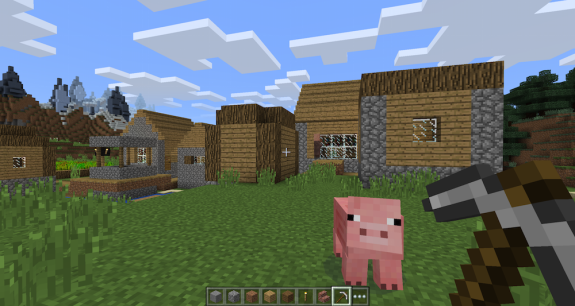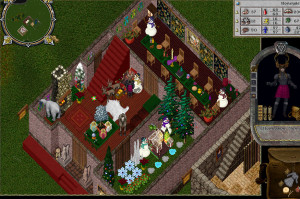What Will the Metaverse Look Like?January 31, 2016 
When thinking about the metaverse you have to consider many factors — accessibility, content availability, interface, social infrastructure, privacy options, and personal expression among many others. If you take it one step at a time you can start to come up with likely scenarios. I had begun the thinking process with an experience in mind akin to MySpace, Squarespace, or Facebook. These are all tools that are (or were) used for some kind of personal expression to be shared on the web. There is of course a distinction to be made between social networks and web site creation tools like Squarespace but they share a lot in common as well. At their core, they make sharing things on the internet very easy and at a low or no cost.
Focusing on social networks for a moment, consider that they allow a person to share things about themselves with their group of friends and acquaintances as well as have some (small) degree of control over privacy settings and how and when they share things with people. But it might be a mistake to take these concepts and translate them directly to a 3D VR space where user profiles become boxed rooms with shared bits of information, video, images, and other types of content lining their walls. Sure, this is somewhat compelling in that it becomes almost like ones room growing up as a teenager where you have your own personal space that you can customize to express who you are with things like posters of your favorite bands or sports stars and a library of your favorite movies and books along your book shelves, maybe even personal notes and photos on your desk. In addition to this, features such as lighting and color can be adjusted to express yourself further. Of course, what depiction of a teenager’s room would be complete without including the angsty music blasting from their stereo. This is a bit dated, maybe a room from the 90’s when I grew up, but I think there are correlations to teenager’s rooms of today. I think a better place to start is to consider what types of content are currently available to be shared and what types of content are likely to be available in the near or distant future within VR. Currently there are photos, videos, audio files, text, 3d and 2d games, 360 degree videos and photos, and that probably covers a majority of the content. Soon there will be much higher quality 360 degree video with depth information and at around the same time we are likely to see the ability to capture 3d scenes with depth from our favorite games and experiences in VR and share those in the 3D medium as well. So imagine you are in a VR experience, let’s say EVE: Valkyrie, and you decide to record a 3D 360 degree video within the game of some crazy move you pull off in your spaceship. You could then share that “video” with other VR users and they could essentially see the experience as you saw it, able to look around at their own leisure and get full positional tracking (within reason). So in that way, as more content (games and experiences) are developed for VR, people can share those things with others without them having to own the content. Early on I think most of the enhanced content that will become available will be primarily created by professionals and advanced content creators rather than the masses. Because of this, I think it will be a medium of curation more so than video is presently. It may be more similar to the early web where people were not necessarily sharing their own videos but rather pulling things from around the web and sharing them in places like Geocities, etc. In fact, back then video was really too bandwidth heavy to even share online. So early on in a metaverse it may become more about curating things you find that are well suited to VR (3d 360 video, games, experiences, 360 photos, etc) than authoring things and displaying them. And let’s be honest, even today with all of the GoPros, smartphone cameras, etc there are still a majority of people consuming rather than creating the content (cat videos, Pew Die Pie, Let’s Play, etc).
In addition to the content outlined above, there is also likely to be new classes of experiences to try, record, and share. So things like eSports might become so accessible and effective in VR that there could be whole industries formed around it with spectating being akin to going to a basketball game but instead of assigned seating in a stadium you can fly your avatar to any and every angle of the arena and watch the action unfold. And along with this ability to spectate, you can record what you see in those 3d 360 video captures I was describing above. Also, real, physical sporting events might be digitized to a degree that includes full motion/depth capture of players so they can be experienced in similar ways as digital based sports. Other types of events such as concerts, dance performances, live theater, etc, might all be adaptable to this type of shift in spectating. The question still becomes: what will a user’s “profile page” look like? Compared to Facebook and Myspace where user’s can customize the content that appears on those pages, in the case of Myspace there was more control over the appearance, this lead to both good and (very) bad designs but either way it was interesting in that it allowed a user to easily change the appearance to express themselves. This could be translated to a 3D medium through these profile “rooms” where users can load various templates to change it from a blank gray room to a space ship, a giant carved out oak tree, or a pineapple under the sea. These rooms would likely only be accessible through teleportation rather than located at a specific place in the metaverse. While I think some form of personal space is likely, I think it is more important to consider avatars as the primary means of personal expression and communication.
Avatar centric design — if you look at Second Life and other MMOs, you will notice that they are avatar centric methods of personal expression. Each player focuses on customizing an avatar as opposed to a space. There are instances of games that use customizable player housing such as Ultima Online, but these are not as common because even in those cases, the majority of player interaction is done in public spaces and as a result the player’s avatar becomes the easiest means of expressing oneself. This is done through things like items and clothing as well as weapons and spells. Advanced players may have items that new players don’t have access to with special particle effects and other visual flairs to distinguish these items from the common ones. This makes sense in an RPG where there is level progression and skill advancement but for experiences that focus on social interaction these items can be made available to new players as well and in fact they generally are through market places where real money can be spent to improve your style just like in real life. With all this in mind, it becomes clear that avatar centric user expression seems the most likely scenario for the metaverse as well. With avatar’s being so important, what will the public spaces look like that they occupy? It would seem important to not only provide a universally accessible “world” within the metaverse, but to allow for easy navigation to content and experiences outside of the metaverse proper. Games and movies are examples of content that would be outside of the metaverse world. This might be through 3D game lobbies and movie theaters, but I think it is likely there will be non spacial representations of these transitions between content as well. So instead of having everything represented by “physical” objects and spaces, some things will be accessed the through interface buttons and links. Interface will be just as important as the world itself, and this UI might stay with you throughout all your travels in VR like the Steam layer on top of games that can be brought up with a button press to quickly access features such as friend lists and quick shortcuts. This interface would likely be heavily focused on hand controls and gestures to bring up and make quick selections with swipes and grabs rather than thumb sticks and gaze selections.
 A user generated content marketplace will make the metaverse more visually diverse than social spaces like Minecraft I’ll wrap it up here even though the topic could have endless discussion. The metaverse is sure to be something that evolves with the medium as more content becomes available and more easily created. There is a broader question of whether something like this will ever exist or will we be stuck with simple OS style navigation of our content and social activities with things like Steam VR or Oculus Home. Whatever it is, I hope it is open and allows for anybody to participate easily while still providing the ability to go deeper and access more advanced abilities and features that give you more control over shaping the world with things like simple markup and scripting languages to build out functionality. It may take a while to develop and there may be several companies vying for this space but I think over the next 10 years we will be surprised by how deep of an experience this can be.
(The top image is “Neon Buddha” by Miksim Loginov from the Render the Metaverse contest) |
||
© 2025 Borrowed Light Studios LLC |



